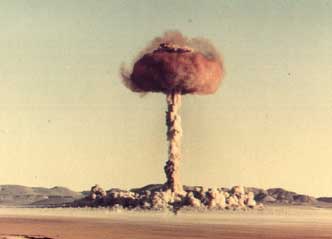BRUSSELS, Belgium
– European officials conducted a simulation showing how
al-Qaida could kill 40,000 people and plunge the
continent into chaos if a crude nuclear device were
detonated outside NATO headquarters.
 "We
are in a race between cooperation and catastrophe," said
former Sen. Sam Nunn, who helped organize the exercise,
dubbed Black Dawn. "To win this race, we have to achieve
cooperation on a scale we've never seen or attempted
before."
"We
are in a race between cooperation and catastrophe," said
former Sen. Sam Nunn, who helped organize the exercise,
dubbed Black Dawn. "To win this race, we have to achieve
cooperation on a scale we've never seen or attempted
before."
Nunn spoke to reporters Tuesday, a day after the
closed-door war games attended by top officials
including the European Union's security chief, Javier
Solana, and his new counterterrorism czar, Gijs de Vries.
In first part of the scenario, European officials
were asked how they would respond to intelligence that
al-Qaida had obtained enough highly enriched uranium to
build a nuclear bomb.
In the second, they were confronted with computer
projections and video displays illustrating the impact
of terrorists exploding the device at NATO's
headquarters on the outskirts of Brussels, immediately
killing 40,000 people, overwhelming hospitals with
hundreds of thousands of injured, spreading panic
through Europe and plunging the world economy into
turmoil.
"Once you are in this phase, there are no good
options," said Michele Flournoy, senior adviser at the
Center for Strategic and International Studies, who
helped prepare the exercise.
More than 50 people from 15 countries and a dozen
international organizations attended the exercise,
mostly EU ambassadors but also civilian and military
officials from NATO, the International Atomic Energy
Agency, Interpol and other bodies.
Nunn appealed for the Europeans to step up funding
for increased protection at sites where weapons-grade
uranium and plutonium are stored, particularly in former
Soviet states.
He said preventing al-Qaida from getting its hands on
such material was the best chance of stopping it from
building a bomb.
"It's well within al-Qaida's operational capabilities
to recruit the technical expertise needed to build a
crude nuclear devise," he said. "The hard part is
getting the nuclear material, but we do not make it
nearly hard enough."
Nunn, a Democrat from Georgia and former chairman of
the Senate Armed Services Committee, helped push through
a $10 billion program in 1991 to destroy and safeguard
weapons of mass destruction in Russia and other former
Soviet republics. But he said at least 60 percent of
sites still must be secured.
He said European leaders should make good on pledges
made two years ago as part of a $20 billion commitment
by the Group of Eight to provide more funding for that
program over 10 years.
They should also push President Bush and Russian
President Vladimir Putin to do more when the G-8 group
of world leaders meets next month in Georgia, he said.
Solana and NATO Secretary General Jaap de Hoop
Scheffer convened the exercise to show the extent of the
danger.
"The threat of catastrophic terrorism is not confined
to the United States or Russia or the Middle East,"
Solana said. "The new terrorist movements seem willing
to use unlimited violence and cause massive casualties."
Nunn urged increased protection for weapons-grade
uranium kept at research sites, which are often poorly
guarded university facilities; accelerated destruction
of tactical nuclear weapons by the United States and
Russia; enhanced international intelligence sharing; and
more help to find new jobs for poorly paid Russian
nuclear scientists.
© 2004 Associated Press.